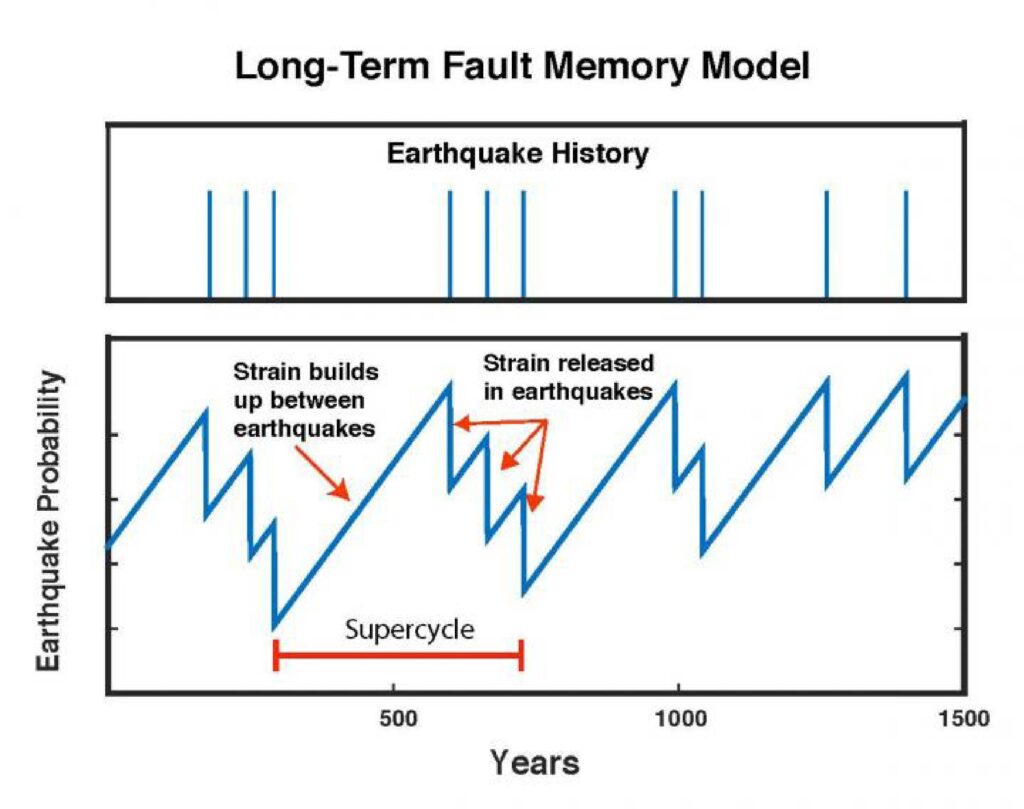Assignment on Earthquake Super Cycle
Guess the Length of the super cycle (time interval between the two successive M-9 earthquakes) assuming that the earthquake fully releases the stress associated with the Pacific plate subduction.
Ans:
From the New model explaining the coexistence of frequent M-8 and infrequent M9 earthquakes we find that, to complete one Super cycle requires approximately 571 years because, from the past record, we know that, in 869 BC, 1611 BC? and in 2011 BC there are three successive large earthquakes occurred and completing three supercycles by releasing all strain of strong coupling.
According to this new model, when the Pacific plate subducts beneath the North American continental plate all strain is not released by small asperities but accumulated for a long time. Then by releasing the entire strain a large infrequent earthquake (M9) is occurred and completes a super cycle.
So, from the new model;
{(1611-869)+(2011-1611)}/2
=571 year
From the above conclusion we can guess the length of the super cycle is 571 years.
Assignment on Earthquake Super Cycle: Q2
Guess the amount of coseismic slip associated with the usual M-8 earthquake, assuming that the seismic coupling coefficient is 0.8 and the recurrence time interval is 100 year
Ans;
We know, the coupling coefficient, x=D/vT0
> 80%=D/2*100
Therefore D=160 cm=1.6 meter (ans).
Where,
X= coupling coefficient= 0.8=80%
D=coseismic slip
V=motion of plate =2 cm/year
T0=Recurrence interval=100 years
So, we can guess the amount of coseismic slip (D) is 1.6 m.
Note:
What is coseismic slip?
In the context of earthquakes and fault mechanics, coseismic slip refers to the rapid, instantaneous displacement or movement that occurs along a fault during an earthquake.
Here’s a breakdown of what that means and its significance:
-
Faults and Strain Accumulation:
- The Earth’s crust is made up of large tectonic plates that are constantly moving.
- Where these plates meet, there are fractures in the Earth’s crust called faults.
- Due to friction, the rocks on either side of a fault often get “locked” together, even as the tectonic plates continue to move. This causes elastic strain (deformation) to build up in the rocks along the fault over long periods (decades to millennia). Think of it like bending a ruler – energy is stored as it deforms.
-
The “Stick-Slip” Process:
- Earthquakes are often described as a “stick-slip” process:
- “Stick” (Interseismic Period): Long periods where the fault is locked, and strain accumulates. During this time, there’s little to no movement directly on the fault itself, but the surrounding crust is deforming.
- “Slip” (Coseismic Period): When the accumulated strain exceeds the frictional strength of the fault, the fault ruptures. The rocks on either side suddenly and rapidly slide past each other, releasing the stored elastic energy in the form of seismic waves – this is the earthquake.
- Earthquakes are often described as a “stick-slip” process:
-
Coseismic Slip Defined:
- Coseismic slip is that immediate, sudden movement that happens at the exact moment of the earthquake rupture. It’s the “snap” as the pent-up strain is relieved.
- It represents the amount of displacement that occurs on the fault plane during the earthquake event itself. This can range from millimeters to many tens of meters for very large earthquakes.
-
Phases of the Seismic Cycle: Geoscientists typically describe the “seismic cycle” in three main phases, all involving different types of slip:
- Interseismic Slip (or Strain Accumulation): The long period between earthquakes where a fault is locked, and elastic strain builds up in the surrounding crust. While the fault itself isn’t slipping, plates are moving, creating a “slip deficit.”
- Coseismic Slip: The rapid, short-lived slip that occurs during the earthquake rupture, releasing the accumulated elastic strain. This is what generates the seismic waves we feel.
- Postseismic Slip: The more gradual, often aseismic (without seismic waves) slip that can occur on the fault or surrounding areas in the days, months, or even years after a large earthquake. This is a form of crustal relaxation and adjustment to the new stress state after the main rupture.
Measurement of Coseismic Slip:
Coseismic slip is crucial for understanding earthquake mechanics and seismic hazard. It’s measured using various techniques:
- Geodetic Data:
- GPS (Global Positioning System) and GNSS (Global Navigation Satellite System): Measure precise changes in ground position before and after an earthquake.
- InSAR (Interferometric Synthetic Aperture Radar): Satellite-based technique that uses radar signals to detect very subtle ground deformation over large areas, providing detailed maps of surface displacement caused by coseismic slip.
- Seismic Wave Inversion: Analyzing seismic waveforms recorded by seismographs to model the rupture process on the fault plane, which can then be used to estimate slip distribution.
- Field Observations: For surface-rupturing earthquakes, direct measurements of offset features (e.g., roads, fences, rivers) can provide a measure of coseismic slip at the surface.
